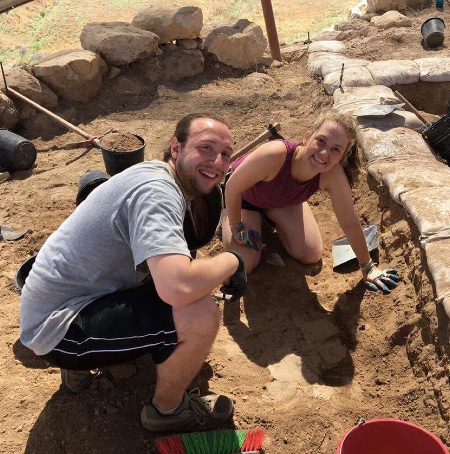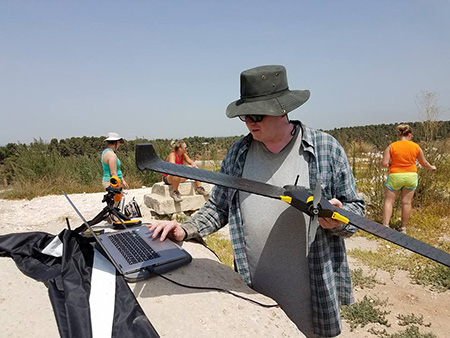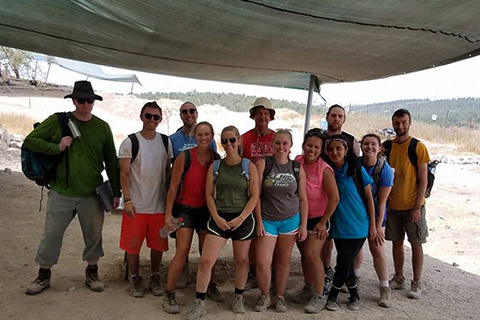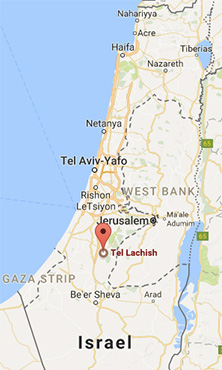- Department of Sociology, Anthropology, Social Work and Criminal Justice
- Sociology
- Anthropology
- Social Work
- Criminal Justice
- Applied Geographic Information Science
- Minors, Concentrations & Combined Programs
- Faculty Publications and Honors
- Departmental Advising
- Scholarships and Awards
- Student and Faculty Awards
- Student Clubs
- Support our Programs
- Community Engagement
- Faculty and Staff
- Events
Students probe mysteries of the past during archeological dig in Israel
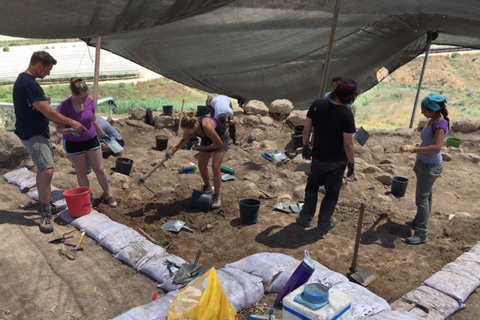
What can you learn from scouring the ruins of an ancient civilization?
Just ask the Oakland University students who spent part of the summer unearthing artifacts in the storied city of Lachish. This ancient Judean town, now national park, is located about 35 miles southwest of Jerusalem and was among the region’s most important cities in Biblical times.
Led by OU professors Michael Pytlik and Jon Carroll, 11 students spent three weeks on an archeological dig searching for answers to age-old questions.
“We’re digging with a purpose, trying to find out when certain events happened and fill in gaps in the historical record,” said Pytlik, director of Judaic Studies at Oakland. “We’re trying to understand the history of social relations between certain groups and how people lived thousands of years ago. It’s an endless search for answers and there’s no limit to the questions that can be asked.”
Pytlik has organized an Israel dig with Oakland students for the past nine years. He says the program draws interest from students of all majors. Journalism major Darcy Dulapa went on this year’s trip in search of intriguing personalities and stories.
Anthropology major Carl Ramsey and journalism major Darcy Dulapa were among the students who took part in the excavation. |
“I was able to meet people from Russia, Sweden, Australia, Korea, and even different states in the U.S.,” she said. “The excavation was not only an archaeological learning experience, but it also opened my eyes to many different cultures.”
Along with jotting down her impressions of the landscape and people in Israel, she also grew fascinated with the dig itself.
“The closer I got with the excavation leaders, the more I wanted to help them dig,” she recalled. “Before I knew it, I was talking like a true archaeologist.”
Pytlik said the dig dispels misconceptions about archeology and the digging process, which is long and painstaking, and doesn’t always yield hidden treasures.
“It’s a different experience than what is shown in documentaries,” he said. “It’s not always glamorous. We find more pottery than gold.”
However, Pytlik added that less glamorous finds, such as pottery, help archeologists determine the relative age of surrounding objects and architecture.
“Pottery is distinguished from period to period according to shape, color, decoration and other characteristics,” he said. “If we can get an idea of how old the pottery is, that can provide clues to how old the surrounding buildings are.”
Combing through the remains of Lachish, Anthropology major Carl Ramsey thought about what life might have been like for inhabitants of this once-thriving metropolis.
“Digging through a building that is 3,000-3,500 years old is an amazing feeling, especially when you think about what you're digging through means,” he said. “Smashed pottery and burned bricks are a good indicator of a destruction, and thinking about what that would've meant for the people of Lachish is intriguing.”
Dr. Jon Carroll programs the drone that the team used to map the topography of the archeological site. |
In addition to the standard archeological tools – trowels, pickaxes, brushes and the like – the team deployed a flying drone to map the topography of the site. Professor Carroll, a registered professional archeologist, said the drone is also useful for detecting vegetation changes, which may signal the presence of archeological deposits in the ground.
“Vegetation differences may indicate where people changed the landscape either intentionally or unintentionally,” he explained. “For example, a deposit full of organic refuse like food waste may change the chemical composition of the soil, thus affecting vegetation growth.”
Along with their daily digging routine, the group visited tourist destinations, including Caesarea Maritima, Akko, Haifa, Ein Gedi and Jerusalem.
“Our time in Jerusalem was especially memorable,” Dulapa said. “We stepped on the same steps that Jesus was noted to have walked upon, and that in itself was just indescribable.”
The group also toured two other archaeological sites, Tel Beit Mirsim and Khirbet Qeiyafa. The latter, which Oakland students excavated in prior years, is believed to be the Biblical city of Sha'arayim. It overlooks the Valley of Elah, where the story of David and Goliath is thought to have taken place.
“The history of the region is most fascinating to me, and seeing things that could be up to 4,000 years old is mind-blowing,” Ramsey said. “Every part of the trip will stick with me forever.”
Plans for next year’s Israel dig are already taking shape. Those interested in participating should contact Pytlik at [email protected]. Learn more about OU’s Archeology in Israel program at Facebook.com/Oakdigs.
Through the Office of International Education, Oakland offers students the opportunity to study abroad in more than 40 countries and study away at nearly 200 universities in North America.
For more information, visit oakland.edu/ie/studyabroad.
Pictured from left: Dr. Jon Carroll, Austin Forgash, Carl Ramsey, Laurel Schaaf, Darcy Dulapa, Dr. Michael Pytlik, Natalie Vandenheuvel, Ashleigh Babjack, Brian Prigel, Shelly Khalish, Caroline Rose and Nicolas Chretien. |
Lachish is located about 35 miles southwest of Jerusalem. |

